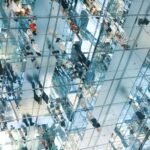It goes without saying that in the artistic world, where creativity finds its voice in myriad forms, sculptors hold a unique place in shaping the tangible essence of their imaginations. One such example in the world of contemporary sculpture is Joseph Slusky. With a career spanning decades, Slusky’s artistic journey in metal and forms has traversed uncharted territories of creative expression.
Born in Philadelphia and raised in Los Angeles, Joseph Slusky’s early artistic inclinations were intertwined with the city’s automobile culture. Immersed in the allure of futuristic car designs and automotive finishes, his fascination with sleek forms and colors laid the foundation for his later sculptural works. Drafting classes in junior high school fueled his passion for car body designs, setting the stage for the unique aesthetics defining his sculptures.
Living in close proximity to the La Brea Tar Pits, an area steeped in prehistoric allure, Slusky found a wellspring of inspiration for his art. The ancient fossils preserved in pools of tar ignited his imagination, leading him to create a series of hand-painted metal creatures called dinosaurs. The connection between the primordial past and the contemporary present became a recurring motif in his work, infusing his sculptures with a sense of timelessness.
From Architecture to Sculpture – A Shift in Pursuit
Joseph Slusky’s journey into sculpture began during his time at UC Berkeley, where he studied architecture. It was a requirement in the curriculum to take a year of sculpture, and this seemingly serendipitous encounter marked the turning point in his artistic pursuit. As he immersed himself in studio art courses, the allure of sculptural creation pulled him towards a new path. When he completed his Bachelor of Architecture degree, Slusky knew that sculpture was his true calling.
Artistic Mentors and Inspirations
The artistic community at UC Berkeley in the 1960s played a pivotal role in shaping Slusky’s artistic vision. Renowned sculptors like Wilfred Zogbaum, Sidney Gordin, and Harold Paris were among his mentors, providing guidance and encouragement. Additionally, exposure to the works of esteemed artists like David Smith, Pablo Picasso, and Giacometti broadened his artistic horizons, influencing his creative approach.
Alchemy of Materials – Welding and Plastic Filler
As a sculptor, Slusky has demonstrated an ability to bring materials to life. Welding became a transformative process, allowing him to give shape to his visions with a sense of immediacy and spontaneity. The use of plastic filler or Bondo provided a means to enhance the visual longevity of his sculptures, enabling him to mold and refine forms with precision. These unconventional materials acted as vehicles for Slusky’s artistic alchemy, turning raw substances into harmonious sculptural compositions.
The Transition to Hand-Painting – A New Frontier
In the mid-1970s, Slusky underwent a significant transition in his artistic practice. He moved away from spray painting his sculptures and embraced hand painting as a new expressive frontier. This shift brought a sense of gestural spontaneity to his works, inviting viewers to engage with the sculptures on a deeper level. Each brushstroke reflected his emotions and creative impulses, imbuing the sculptures with a sense of dynamism and fluidity.
Cultural Encounters – Sweden and London
Venturing beyond the borders of the United States, Slusky’s artistic journey led him to Sweden and London, where he experienced new cultures and artistic landscapes. In Sweden, he found inspiration in remnants of farming equipment, forging connections between nature and machinery in his sculptures. London’s vibrant art scene and exposure to British sculptors infused his works with a touch of British flair, expanding the palette of his sculptural language.
A Dialogue Between Sculptures and Drawings
Joseph Slusky’s artistic realm has a compelling dialogue between his sculptures and drawings. Drawing is a more immediate and direct medium, allowing the rapid generation of ideas and images that influence sculptural forms. While not seeking to replicate the drawings, the process keeps his mind limber and agile in confronting the more intransigent metal media. The interplay between these two forms of expression enriches his artistic language, presenting viewers with interconnected glimpses into the artist’s creative world.
To conclude, Joseph Slusky’s sculptural language explores the unknown, a journey of alchemical transformation that transcends conventional boundaries. From his roots in Los Angeles’ automotive culture to his experiences in Sweden and London, each chapter of his life has woven threads into the tapestry of his artistry. The fusion of materials, the interplay of forms, and the dance of colors reflect an artist in constant pursuit of discovery.










